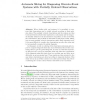Free Online Productivity Tools
i2Speak
i2Symbol
i2OCR
iTex2Img
iWeb2Print
iWeb2Shot
i2Type
iPdf2Split
iPdf2Merge
i2Bopomofo
i2Arabic
i2Style
i2Image
i2PDF
iLatex2Rtf
Sci2ools
AIIA
2005
Springer
2005
Springer
Automata Slicing for Diagnosing Discrete-Event Systems with Partially Ordered Observations
Abstract. When dealing with real systems, it is unrealistic to suppose that observations can be totally ordered according to their emission dates. The partially ordered observations and the system are thus both represented as finite-state machines (or automata) and the diagnosis formally defined as the synchronized composition of the model with the observations. The problem we deal with in this paper is that, taking into account partially ordered observations rather than sequential ones, it becomes difficult to consider the observations one after the other and to incrementally compute the global diagnosis. In this paper, we rely on a slicing of the observation automata and propose to compute diagnosis slices (for each observation slice) before combining them to get the global diagnosis. In order to reach this objective, we introduce the concept of automata chain and define the computation of the diagnosis using this chain, first in a modular way and then, more efficiently, in an in...
| Added | 26 Jun 2010 |
| Updated | 26 Jun 2010 |
| Type | Conference |
| Year | 2005 |
| Where | AIIA |
| Authors | Alban Grastien, Marie-Odile Cordier, Christine Largouët |
Comments (0)

